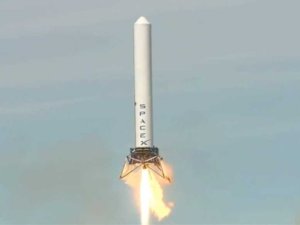Grasshopper, The Eyes of Texas are Upon You
It is definitely space themed weekend in the Lone Star State. After meeting with a Texas House of Representatives committee yesterday to discuss a potential commercial spaceport in Cameron county, SpaceX founder Elon Musk delivered a keynote address at the South By Southwest Festival in Austin. But that wasn’t all, during the speech Musk showed new footage of a Grasshopper test flight, which was accompanied by the following press release.
SpaceX Release:
SpaceX’s Grasshopper doubled its highest leap to date to rise 24 stories or 80.1 meters (262.8 feet) today, hovering for approximately 34 seconds and landing safely using closed loop thrust vector and throttle control. Grasshopper touched down with its most accurate precision thus far on the centermost part of the launch pad. At touchdown, the thrust to weight ratio of the vehicle was greater than one, proving a key landing algorithm for Falcon 9. Today’s test was completed at SpaceX’s rocket development facility in McGregor, Texas.
Grasshopper, SpaceX’s vertical and takeoff and landing (VTVL) vehicle, continues SpaceX’s work toward one of its key goals – developing fully and rapidly reusable rockets, a feat that will transform space exploration by radically reducing its cost. With Grasshopper, SpaceX engineers are testing the technology that would enable a launched rocket to land intact, rather than burning up upon reentry to the Earth’s atmosphere.
This is Grasshopper’s fourth in a series of test flights, with each test demonstrating exponential increases in altitude. Last September, Grasshopper flew to 2.5 meters (8.2 feet), in November, it flew to 5.4 meters (17.7 feet) and in December, it flew to 40 meters (131 feet).
Grasshopper stands 10 stories tall and consists of a Falcon 9 rocket first stage tank, Merlin 1D engine, four steel and aluminum landing legs with hydraulic dampers, and a steel support structure.


